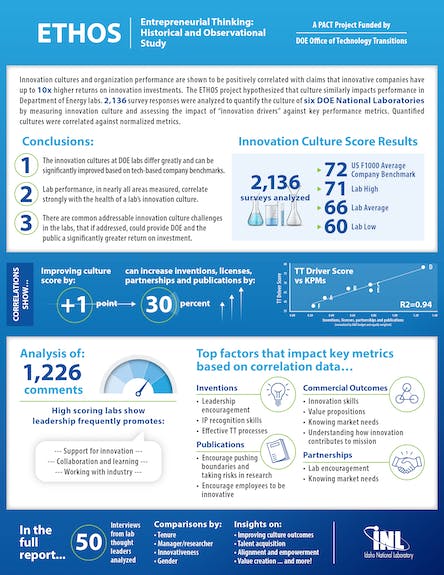The United States invests more than $30 billion every year in its national laboratories, which are owned and operated by the U.S. Department of Energy. Their mission, according to DOE’s mission statement, is to “ensure America’s security and prosperity by addressing its energy, environmental and nuclear challenges through transformative science and technology solutions.”
Getting the highest return on the public’s investment in research and development is always a priority to DOE and its contractors. Considering there are 17 national labs, managed by an assortment of contractors, there’s likely to be variation in how each of them fulfill the overall mission.
This is especially true when it comes to innovation, said Jason Stolworthy and Jim Keating of Idaho National Laboratory’s Technology Deployment office. Stolworthy and Keating have produced a report for DOE’s Office of Technology Transitions entitled “Entrepreneurial Thinking: Historical and Observational Study (ETHOS).” The report describes itself as “an evaluation of cultural impact on technology transfer performance in semi-homogeneous R&D organizations.” With help from two private firms, InnovationOne of Scottsdale, Arizona, and IdeaScale of San Francisco, the two have analyzed 2,136 survey responses across six DOE national laboratories, quantifying innovation culture and assessing the impact of “innovation drivers” against key performance metrics.
Although the push for innovation, tech transfer and commercialization dates back to 1980, there has been a renewed call for more from DOE’s highest level.
“Innovation turns ideas into practical solutions that advance the mission of the organization,” said in a statement from Energy Secretary Jennifer Granholm’s Energy Advisory Board. “Innovation needs to permeate the DOE more than ever for the United States to remain the world leader in technology,”
Management guru Peter Drucker is quoted to have said “culture eats strategy for breakfast,” meaning if you get the culture right, everything else falls into place. This doesn’t mean strategy isn’t important, but rather that it’s ineffective without the right culture. It is a company’s culture that determines how effective its people are, so culture and strategy must be aligned.
Culture isn’t about casual dress Friday or weekly potlucks. It’s about how employees behave in critical situations, how they manage pressure and respond to various challenges, and how they innovate and treat partners, customers, and each other.
In conducting their study, Stolworthy and Keating discovered innovation culture at the six DOE labs surveyed differed greatly. “There are common opportunities with respect to innovation culture in the labs, that if addressed, could provide DOE and the public a significantly greater return on investment into the labs,” they wrote. In fact, a key finding was that a one-point difference in a lab’s innovation culture score on a 100-point scale corresponded with a 20-30% increase in performance of key R&D outcomes.
Based on their findings, lab leadership should consider the following recommendations:
- PROMOTE: Get the message out that a culture of innovation profoundly improves lab performance. “Highly innovative organizations learn to achieve their goals while funding and supporting innovation activity, which in turn improves outcomes and financial performance. It is not one or the other.”
- INVEST: Compared to private industry, the labs have the greatest opportunity for improvement here. “Invest in employee skills and creativity, technology and financial support, and employee and team empowerment.”
- INNOVATE: Leaders at every lab need to improve engagement with employees. This will accelerate experimentation and improve collaboration, with rewards for collaboration, risk-taking, and empowerment.
At higher-scoring and lower-scoring labs, leadership is advised to establish and incorporate innovation strategies into strategic planning. “Leaders need to communicate their vision and strategies frequently and ask employees and external partners to jump in and recommend solutions,” they wrote.
If DOE prioritizes and incentivizes it, innovation will happen. It will involve envisioning the culture, defining the goals, and communicating them consistently.
“This was a huge study on innovation across six DOE national labs – the first of its kind,” Stolworthy said. Benchmarking the labs against each other and against industry offers a baseline DOE has lacked. “As a result of this study, we now know ‘which knobs to turn’ in the labs to get more of what we want,” he said.
From taking part in ETHOS, each participating lab received a specific action plan to improve its culture of innovation. Using a methodology developed at the INL to measure incentive alignment, this was the first time the alignment of incentives was considered both internally and with external stakeholders.
“The DOE labs are working closely together, learning from each other, and are committed to excellence. This is good for us and for our stakeholders,” Stolworthy said.
If you have questions regarding the report, send an email to [email protected].






